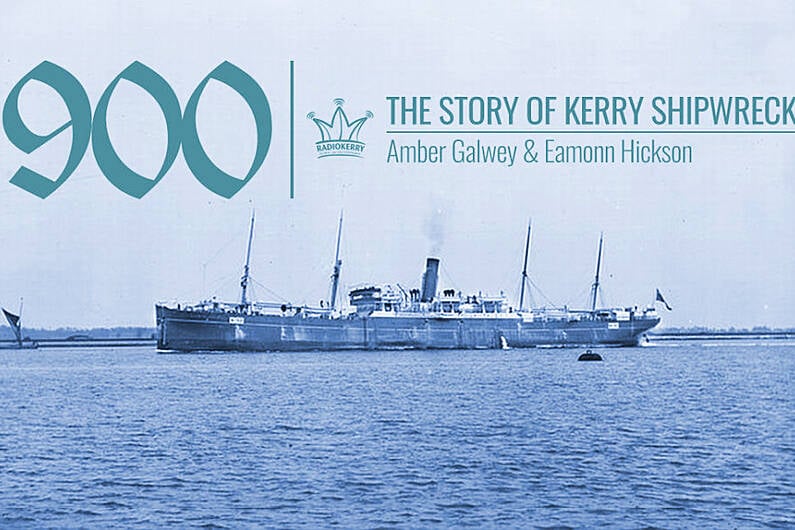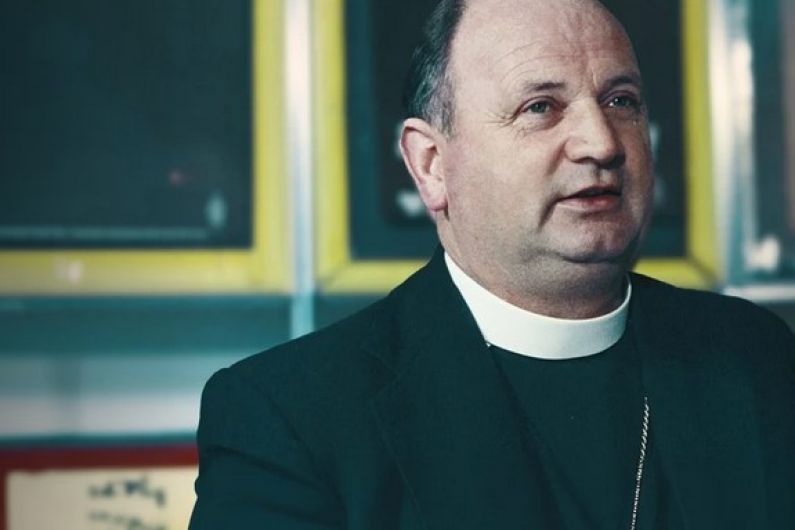In the waters off the Kerry coast, ghosts have found their resting place. The remnants, the fragments of scuttled ships, might be rotting in the salty water, but their stories live on. Every ship’s demise, every overturned cargo, every lost life has been levelled out by the Atlantic waves until all that remains is a series of dots stretching from Kerry Head, through Tralee Bay, out by the Maharees, to Brandon Bay, to the Blaskets, to Inch, to Portmagee, to the Skelligs, to Kenmare and beyond, into the depths.
Some ships were crippled by engines of war. Some were guided toward ruin by jealousy. Even a few were genuinely misfortunate, their valuable cargo becoming the thing that’d become their undoing.
A few met their end within sight of the shore and became part of the local folklore, including the flaming Manchester Merchant in Dingle Bay, the Querbra which struck a rock north of the Great Blasket, or the Kincardine, a collier, that was torpedoed west of Brandon Point.
Hundreds of shipwrecks surround the Kerry coast. The Kingdom is unique as it is often the first—or last—land one sees as their ships make the long journey across the Atlantic. During the Great Wars, it was a staging post for many U-boat attacks on allied forces. In times of peace, many fishing vessels trawled the waters off the coast in search of a living. The majority of ships negotiated the Kerry waters safely, but some did not.
Some of these shipwrecks are known to locals as remnants of them can still be seen along Kerry’s shores, including the Sunbeam in Rossbeigh or the Thetis in Beale, while in other cases memorials have been erected locally to those who tragically lost their lives off our coast, like those who perished on the Port Yarrock and are buried in Killiney.
Their graves are now merely little reds dots on interactive maps or faint memories in some locals’ minds. In documenting some of those lying in Kerry waters, we’ll try add some context to their final voyage.
* * * *
Manchester Merchant
Steamship
Dingle Bay, 4.5km WNW of Rosbehy Point
15/01/1903
Built in 1900, the SS Manchester Merchant was a 5,600-ton steamship, built in Newcastle-Upon-Tyne in the UK. At 137 metres in length, nearly the length of the Croke Park pitch, the Manchester Merchant was designed to become a major player along the Atlantic trade routes. Within three years though, it’d be resting in Dingle Bay, between Inch and Rossbeigh beaches.
Although originally built for the newly formed Manchester Liner Company, the SS Manchester Merchant was requisitioned by the British government immediately after its completion to transport troops, supplies, horses and ammunition to South Africa during the Boer War. When the war ended, it was returned to its owners, to begin what it was built to do: transport goods from the New World to the UK.
Early in 1903, it departed New Orleans with its cargo of 13,000 bales of cotton for the Lancashire cotton mills. The vessel, commanded by W.P. Couch and manned by a crew of 56, was also carrying 100 barrels of turpentine, soap, pitch, pine and grain. It approached the Kerry waters, the first land sighted in thousands of miles. However, the beginning of the end for the Manchester Merchant had already begun.
The valuable cargo had caught fire. The ship sought refuge in Dingle Bay and dropped anchor near the entrance to Castlemaine harbour. As the fire intensified, the crew threw the turpentine overboard. With efforts to fight the fire proving fruitless, most of the crew took to the lifeboats, leaving the master and a handful of the crew to scuttle the ship in shallow water, which they did on January 15th, 1903. There was no loss of life in this incident.
The captain gave the ship’s bell to locals as a token of gratitude for their assistance. The bell of the Manchester Merchant is housed in the Roman Catholic church at Inch.
Co-incidentally, the bell has been removed from St Joseph’s Church in Inch for refurbishment.
I spoke to Dora McCarthy, who’s part of Inch Community Council.
The bell of the Manchester Merchant was saved from a watery grave 117 years ago. What condition is it in now?
Bernard Reidy owns Trophy World in Tralee, where the bell was refurbished. He said the bell, which is about 18 inches in height and 15 inches in diameter, was constructed in 1899. Over the years, the copper bell became stained and mouldy.
The material – copper – is frequently used for ship and church bells, due to its tone when struck.
As for the condition of the Manchester Merchant… that’s another story. Karl Brady is an underwater archaeologist with the National Monuments Service.
The wreck of the SS Manchester Merchant lies in over 11m of water and is orientated NE–SW, with its bow to the NE. It lies largely intact, equidistant between the Iveragh and Dingle Peninsulas. And, sometimes, when the tide is out, it’s said a part of the Merchant peers above water, well over a century after it came to rest.
* * * *
Port Yarrock
Barque
Kilcummin Strand, Stradbally, Brandon Bay
28/01/1894
The story of the Pork Yarrock is a long and complex one. It set sail in July 1893 – but it would only brave the sea for a couple of hundred days before succumbing to the sea at Kilcummin Strand.
This incident is recalled as a terrible, but unnecessary tragedy.
Twenty British and Scandinavian crew were on board, and eight of them were only 19-years-old or younger.
Its journey was a difficult one; the Port Yarrock met terrible weather conditions and that coupled with stubborn owners, who refused offers of help locally, and an indecisive captain led to her demise and resulted in the deaths of everyone on board.
The story of The Port Yarrock is detailed in A Gallant Barque, a book researched and written by Sheila Mulcahy, who grew up in Brandon Bay. This book tells the full story of the Port Yarrock’s final journey.
The Pork Yarrock left Southern California filled with 2,200 tons of copper ore and was bound for Cobh, which was known as Queenstown at the time, however Antwerp was its final port of call.
Despite having a sick, exhausted and starving crew, the captain refused local offers of assistance to tow the ship to safety and attempted to progress to Tralee. This was on the orders of the boat’s owners, who he’d contacted in Glasgow.
Philip Baines, a crew member on the Port Yarrock, kept a record of his time at sea. In this log, he details exactly what the conditions were like. Sheila Mulcahy studied this log as part of her research into the book:
The owners promised a tug from Liverpool – it’s believed this would have been cheaper than accepting local help, however, by the time it was to arrive it would be too late.
Everything that could’ve gone wrong, went wrong during this voyage, according to Sheila. But she says it all could have been avoided:
Weather conditions deteriorated and the sea raged furiously, The Port Yarrock was blown across Brandon Bay and driven up on the sands of Kilcummin Strand.
Attempts were made to help the crew by Fenit Lifeboat and lifesaving equipment was sent from Dingle, but that arrived too late.
All those on board sadly died – three bodies, which included the captain, washed up weeks before the others were found. Sadly, seven of the 20 bodied were never recovered.
Many of those who perished were buried in the nearby graveyard at Killiney.
Many people who were lost of the Irish coast were buried locally, according to Mike Lynch, Archivist with Kerry Library:
The inquest into this terrible event found mismanagement and callousness contributed to the tragedy.
In the following months, a British Board of Trade inquiry in Glasgow severely condemned the owners. They also highlighted the ship was under staffed and also made reference to the fact that many of the crew were young and inexperienced.
Four years later, in 1897, the Merchant Shipping Act was amended to include insufficient crew numbers as being among the reasons for preventing a ship from leaving port.
Following this tragedy, a telegraph office was established at Castlegregory and the Fenit lifeboat was replaced by a larger craft. A Coast Guard station was also built at Brandon.
Some parts of the Port Yarrock can still be seen in the community today. Sheila Mulcahy paints a picture of what exactly remains in the community and where it can be seen today:
This terrible tragedy is remembered by the local community each year, they gather to celebrate Mass on Kilcummin Strand:
* * * *
Lady Nelson
Cargo ship
Little Skellig, Kerry
14/10/1809
In October of 1809, the Freeman’s Journal reported on a tragedy off the Kerry coast.
We are concerned to hear that the ship Lady Nelson, Bernard Wade master, from Oporto to Liverpool, about 11 o clock on the night of the 14th, struck on a rock between the Skelligs and the mainland, and instantly went to pieces; and melancholy to add, the captain and crew, consisting of 22 men and also three women, a child and a gentleman passenger were lost, two of the crew only excepted.
Sometimes, ships can meet their end due to an unusual cocktail of ingredients. Oftentimes, it’s the swell, the seas or acts of war which scuttle the ships. Less often, it’s jealousy, sex and stubbornness.
In the case of the Lady Nelson, which was smashed off the Skelligs in 1809, all the ingredients for high drama were there: sex, alcohol, jealousy, anger, dangerous seas and loss of cargo, ship and life.
But first, the Freeman’s Journal in October 1809, gave more details.
Several casks of wine have within the last week been thrown ashore and picked up by boats on the western coast of the county Kerry – a part of the wreck of a vessel was also discovered by a boat of Mr. Rice’s, and brought to Dingle; on which were found the captain, his wife and child, and maid-servant, quite dead, and two men, part of the crew, nearly in the same state; the latter, however, by proper care and attention, are now perfectly restored. From these men (one of whom is a Swede and the other an Italian) it has been learned, that the vessel was the Lady Nelson of Dublin. The survivors were four days and nights exposed to hunger in the wreck before they were taken up.
A lot of information remains about the Lady Nelson, courtesy of Master of Philosophy James ‘Jimmie’ Robinson – more on him anon. Before it met its end, the Lady Nelson had a vivid and colourful life. It was a full rigger, 201 tonnes.
The earliest mention of the Lady Nelson in the Lloyd Registers is found for 1802. Its trade route was given as plying between Greenock (Scotland) and Newfoundland (Canada). This report also stated that the ship had been captured as a prize.
In 1804, the ship plied between Greenock and Lisbon (Portugal). For 1806, the Lady Nelson was captained by B. Wade and ownership passed to Shaw & Co. Based in Greenock, the vessel plied between Dublin and Oporto.
Master of Philosophy James ‘Jimmie’ Robinson has written historical papers relating to persons, places and events. Among other works, he published a nine-generation family history entitled, ‘The Robinsons of North Kildare – 300 Years of Family History’.
He has a particular interest in the Lady Nelson.
As Jimmie said, its trade routes were given as Dublin to Oporto and London to Brazil. This latter trade route suggests that it was part of the Slave Trade Triangle.
The transatlantic slave trade took place between the continents of Europe, Africa and America from 17th to 19th Century. The abolition of the British slave trade took place in February 1807, two years before the loss of the Lady Nelson. However, the slave trade continued for some years afterwards.
Jimmy Robinson outlined the main cargo of the Lady Nelson when it met its demise.
Some thirty years after the loss of the Lady Nelson, Lady Chatterton recalled the saga as told by the survivors.
In the winter of 1809, the Lady Nelson from Oporto to Liverpool, laden with wine and fruit, struck on the Skelligs and went to pieces. The mate had warned the captain during the evening of his proximity to this dangerous rock; but the captain, who was drunken and jealous, (his wife having seconded the representations of the mate), refused to put the vessel about and in a couple of hours she struck. The mate and three hands saved themselves upon a part of the wreck, which was drifting about for three days, during which time they subsisted on the oranges and other fruit which, when the ships went to pieces, covered the sea around them. The mate, who was an excellent swimmer, procured these oranges by plunging off the spar and bringing them to his companions. On the third day, one man became delirious, saying that he should go ashore to dine. He threw himself off the spar and sank. Shortly afterwards, the survivors were picked up by a fishing boat belonging to Dingle, which had come out looking for a wreck. The crew consisted of a father and his four sons, and had two pipes of wine in tow when they perceived the sufferers, finding their progress impeded by the casks and that the tide was sweeping the seamen into the breakers, where they must have been dashed to pieces, the old man nobly cut the tow line, abandoning what must have been a fortune to his family, and by great exertion picked the men up just when the delay of a second would have caused their destruction.
The Lady Nelson’s main cargo was wine, bringing the notion that the captain may have been involved in smuggling. Jimmie thinks there was a Kerry element to this.
* * * *
Unknown Ballyheigue
Unknown type
Ballyheigue Strand, 310m SW of Ballyheigue carpark
1825
Not a lot is known about this shipwreck, even its name is still a mystery. However, in the 1960s, the wooden remains of this wreck were exposed on the lower foreshore of Ballyheigue Strand.
Local historian Eddie Roe did a lot of investigation into this wreck and based on the artefacts recovered from it, it’s understood its probable date was in the 18th century and it’s thought it was a trader.
In 2014, when this shipwreck was once again exposed, it was reported that members of the public were removing parts of it. The Underwater Archaeology Unit of the National Monuments Service was called and carried out a survey and targeted excavations of the exposed parts of this shipwreck.
Fragments of broken pottery, green glass bottles and barrel material had been scattered due to damage caused by people who searched the wreck site, when it first became visible.
All work by the Underwater Archaeology Unit was subject to tidal movements; the tidal window was short, resulting in limited time on the wreck site.
Other items from this shipwreck were deposited in the County Museum by Eddie Roe’s family after his death.
Helen O’Carroll, curator of the County Museum, describes what artefacts they have from this wreck:
Since the remains first appeared, locals have removed artefacts, which include pieces of intact and broken ceramics such as Westerwald pottery and Frechen stoneware from Germany and fine table wares from Bristol. It’s believed that many of these artefacts are features in houses throughout Ballyheigue.
Although, the name of this ship isn’t known, research suggested that it may have been the Wind Trader or The Golden Lion.
Local historian Brian McMahon tells us more about The Golden Lion:
* * * *
Warner, Eupion, Argus, Stanfriel, Cornelis Ferdinand, Mary & Caroline and the Delamere. These are just seven of the estimated 900 shipwrecks off the Kerry coast.
The Warner was shipwrecked in 1917 50kms north-west of Slea Head, the Eupion tanker was headed for the Shannon Estuary a year later when it met its end; the Argus came to rest 75 kms from Kerry’s shore, the Stanfriel, a steam trawler sunk in 1933, rests a few miles south of the Argus. Cornelis Ferdinand sails no more – it’s last stop in 1995 being 80kms from Slea Head. The Mary & Caroline, a barque, a three-masted sailing boat, is well settled over 90kms out from West Kerry, having taken a seat in 1847. The Delamere was sunk a little further out… and in water a little deeper.
Unlike so many wrecks off the Kerry coast, it came to rest not on Porcupine Bank, but in the Porcupine Seabright. The former, the bank, has water with depths of up to 300m. From the Kerry coast, the seabed slopes gently downward. For example, if one were to walk along the sea bed from Banna and head due west, by Brandon Point the water would be around 50 metres deep – about 160 feet.
Due north from Slea Head, the water reaches around 100 metres in depth. A fall of 100m over 50km, a gentle slope. This continues for about another 140 kms. However, the continental shelf then ends abruptly. If our seabed walker were to turn south at this point, they’d descend quickly; over the next 100kms, the seabed drops to 2,000m – or 2km – in depth.
A crafty navigator could avoid these depths, as the continental shelf off the Kerry coast extends northwards and out into the Atlantic, leaving a deep depression in the middle, some 150kms out from Skellig Michael.
* * * *
Big Cat
Fishing trawler
Beginish Island, Valentia Harbour
13/01/1989
Not all shipwrecks were consigned to be hidden beneath the Atlantic waters within minutes. The Big Cat, a Spanish fishing trawler, leaned against the western cliffs of Beginish Island like a drunken man against the counter top, before succumbing to the waves in the days that followed.
Timothy Lyne, a native of Valentia, worked in the Coastguard station for 40 years. He wasn’t on duty that day in 1989 when the trawler first made the call for help, but he knows the tales. He says that, at 7:30 in the morning of Friday the 13th, 1989, the Big Cat suffered engine trouble – he surmises that it might have simply run out of fuel. Regardless of the cause, it was powerless as the waves pushed it up against the rocks on the side of Beginish island.
Michael O’Connor, one of five volunteers with Valentia Coast and Cliff Rescue, recounts the rescue.
Michael O’Connor and the other four volunteers were recognised for their bravery, when 11 survivors were rescued from the Big Cat Spanish fishing vessel.
Three men died.
* * * *
SS Premier
Steel steamship
Shannon Estuary, between Kilcredane Light and Beal Bar Buoy
26/11/1898
The SS Premier was a British cargo ship and was built in 1894; a mere four years later it sunk following a collision.
Now, it’s covered by over 21 metres of water just 2km North West of Beal Point.
The 537-ton cargo steamship was built by J. Shearer & Sons, Kelvinhaugh, Glasgow. It was 53m long and 7.9m in breadth and had a two-cylinder steam compound engine with one boiler.
At the time of its loss, in 1898, it was owned by J. Simpson of Glasgow.
The SS Premier was under charter to the Limerick Steamship Company with a 600-ton cargo of sugar (for Messrs Cleeve of Limerick) when it sank.
The steam coaster was captained by Murray and had a crew of 14. It was on the final leg of its journey from Hamburg to Limerick when it was involved in a collision with the paddle steamer, Mermaid between Scattery Island and Kilcredane Point.
It is unclear how the collision happened but the Mermaid, which was outbound from Limerick to Waterford, struck the SS Premier on the port side and tore open her plates.
The Premier sank within fifteen minutes. Its crew took to the boats and were luckily picked up by a passing steamer.
The Mermaid's bow was badly damaged and it was forced to return to Limerick for repairs. The wreck of the Premier is now known locally as the ‘Sugar Boat’.
* * * *
Santa María de la Rosa
Blasket Sound, Stromboli reef, 200 yards SE of.
21/09/1588
In 1588, the Spanish Armada departed the Iberian Peninsula with a fleet of 130 ships. What followed was the loss of nearly half that fleet.
The Spanish Armada had lost over 2,000 men during its naval engagements with the English, but its journey home proved to be far more deadly.
By the time the “Great and Most Fortunate Navy” finally reached Spain in the autumn of 1588, it had lost as many as 60 of its 130 ships and suffered some 15,000 deaths.
In 1588, the Santa María de la Rosa joined several other ships in seeking shelter in the Blasket Sound off the West Kerry coast.
Almost immediately, her anchor dragged and the ship was torn out on a reef. It sank quickly, taking all on board to their deaths except one, the pilot’s son, Juan Antonio De Manona.
It’s not hard to imagine a local radio news report from Slea Head, had radio been invented.
The sole survivor of this tragedy has spoken of the possible presence of a valuable treasure onboard the ill-fated Santa María de la Rosa. Juan Antonio De Manona, son of the captain, reached the shore upon a wreckage and was taken prisoner by the English. According to well-placed sources, the ship went down with three chests full of gold and silver, along with cups of gold and fifty great pieces of brass.
Whether or not the captain’s son spoke the truth, it’ll never be known.
What cargo and what ammunitions did these ships of the Spanish Armada carry?
Karl Brady works in the Underwater Archaeology Unit with the National Monuments Service He’s has dived to a number of wrecks off the Irish coast. Here’s a selection of what he found of Sligo.
In 1968, explorer and adventurer Sydney Wignall advertised for divers to take part in his forthcoming expedition to find the Santa María de la Rosa off Slea Head. The advertisement stated: this is not a treasure hunt, if there is any treasure and we find it, then that will be an added bonus. He was granted a licence to salvage the wreck by the Spanish government in return for 20% of any treasures recovered.
No chests of gold or silver were ever found…. As far as we know.
However, in 2002, the Kerryman newspaper reported a local councillor believed that valuable material, including treasure, was secretly removed from the wreck of the Santa Maria de la Rosa.
The issue of buried treasure has long fascinated people. However, were any treasure to be found, who’d own it? Underwater Archaeologist Karl Brady casts some light on this.
According to details from Sydney Wignall’s dive, the Santa María de la Rosa wreck is on a flat shingle bottom in 35-40 meters.
Over the past 432 years, it has sat between Slea Head and the Great Blasket, possibly being unsettled by Atlantic storms and twisting currents. Just shy of 300 people died when it met its end. And, it’s no surprise, it remains one of the biggest marine tragedies ever to occur off the Kingdom’s coast.
* * * *
Thetis
Sloop (sailboat)
Beale Bar, Shannon Estuary, off townland of Corcas and Sandhills
1834
Thetis is a wreck that many may be aware of, as it can be seen just off the car park in Beale.
All that remains from this sailboat is a few broken wooden ribs, the rest is buried in the sand.
Its story is a sad one, as nine people lost their lives and the surviving crew, ended up facing the courts on smuggling charges.
Mike Lynch, archivist with Kerry Library, tells us about the history of the ship:
This ship had a colourful history and in April 1834, just seven months before it sank, its passage was delayed as a man wanted in relation to a crime was on board, according to Mike Lynch:
The Thetis was laden with pine timber on what would be its final journey on November 30th 1834. It sought shelter from high seas and relentless storms in the estuary bay.
Captain Younghusband was in charge of the vessel, which had left from Quebec in Canada and travelled across the Atlantic.
On December 8th, a Scottish newspaper called The Caledonain Mercury published the following announcement stating Thetis had floundered. It read:
We lament to announce, that accounts reached town last evening of the loss of the fine brig Thetis, of and for this port from Quebec, timber laden, the property of Francis Spaight, Esq. The account has it that she foundered an Monday night or early yesterday morning, upon Beale bar in the Shannon, when the wind blew furiously from the west.
The vessel's boat was cast ashore at Tarbert. This morning we received further intelligence in a more accurate shape. The master, Young husband and crew are safe and it is hoped the vessel and cargo will be preserved.
Despite the initial reports, that stated the crew and captain were safe, that was sadly not the case. A report on the shipwreck on Beale Beach states that nine people lost their lives as this tragedy unfolded.
During its final voyage, Thetis met many difficult conditions and just as it was within range of shelter, it was hit by large waves which battered the ship and drove it onto the shore of Beale Bar.
It was battered by the tide and the ship’s masts broke. Some of the crew were swept overboard but others managed to cling to the ship.
Locals and the Coast Guard quickly made their way to the scene to help. Some of the crew were able to swim ashore, but sadly nine people lost their lives. Some of those who survived the tragedy, were cared for by locals in their homes.
The remains of the crew washed ashore near Beale and they were later buried at Lissadooneen Fort.
The captain and his surviving crew were hailed heroes in the initial aftermath, until the salvage operation unearthed contraband tobacco on board.
The crew were arrested, taken to Tralee and tried for smuggling.
Mike Lynch recounts what was found during the salvage operation:

* * * *
U-Boats sinking ships off the Kerry coast
A decision made by German leadership during World War I led to a scattering of shipwrecks in Kerry’s waters. Over 100 years on, all that remains are disintegrating hulls and red dots on maps. How did this come about?
In May of 1916, the German government pledged to give adequate warning before sinking merchant and passenger ships and to provide for the safety of passengers and crew. This, the Sussex Pledge, had come about after the sinking of the French passenger steamer in the English Channel in March of that year. The Sussex had been torpedoed, leaving 80 people dead and others injured.
The pledge was broken within a year.
It resulted in a host of ships being sunk off the Kerry coast in the immediate aftermath.
The Cornelia, the Holgate, the Nailsea Court, the Baron Wemyss, the Hopemoor, the Bulgarian, the Neuquen. A small number of ships which are resting in Kerry waters following fatal torpedo wounds.
What would a news broadcast from Kerry have sounded like in 1917?
The German offensive continues off the Kerry coast, as reports come through of another U-Boat attack. This time, it’s being reported that local fishermen first saw the explosion. It brings to over a dozen the number of ships sunk by the belligerents.
January 19th, 1917
Nailsea Court – Steamship
Sunk 23-28 miles WNW of Skelligs lighthouse
January 20th, 1917
Bulgarian - Steamship
Torpedoed and sunk 93 km west of the Fastnet Rock by SM U-84 with the loss of fourteen of her crew. Nine survivors were taken as prisoners of war
The same day, January 20th
Neuquen – Steamship
20 miles NW by W of the Skelligs.
Eighteen of the crew lost
14th February, 1917
Hopemoor - Merchant Vessel
20 miles NW of the Skelligs
Her crew survived
27TH February, 1917
Tritonia – Steamship
Sunk 20m NW of Tearaght Island
Two people lost.
March 6th, 1917
Cornelia - Steamship
36 miles WNW of the Skelligs
March 7th, 1917
Baron Wemyss - Steamship
135 km north west by west of the Fastnet Rock
Two of her crew lost
13th March, 1917
SS Warner – Steamship
Southwest of Ireland (offshore at Loop Head)
13 crew lost (never seen again)
One was wounded and later died.
Seven were taken prisoner by the U-61
14th March, 1917
SS Paignton – Steamship
40 miles NW of The Skelligs
One person lost
27th March, 1917
Holgate - Merchant Vessel
Sunk 19km NW of Skelligs
5th April, 1917
SV Dunkerquoise –Schooner
45m west of the Blaskets
30th April, 1917
Northwaite – Collier
Sunk 45m NW of The Skelligs/20m WNW of the Blaskets
12th May, 1917
SS San Onofre – Steamship
Sunk 64m NW from The Skelligs
One person lost
18th May, 1917
SS Penhale – Steamship
72m NW of Tearaght Island
One person lost
It continued into World War Two…
Langleeford (SS)
14 Feb 1940 - Steamship - Fastnet, 70m NW –
- Sunk by U-26 (Heinz Scheringer)
- Position - 51° 40'N, 12° 40'W - Grid BE 3332
- Complement - 34 (4 dead and 30 survivors)
At 08.00 hours on 14 Feb 1940 the Langleeford, a straggler from convoy HX-18, was hit amidships by a torpedo from U-26, broke in two and sank within 13 minutes about 70 miles northwest of Fastnet, Ireland. Four crew members were lost. The Germans questioned the survivors, handed over two bottles of rum, 100 cigarettes, bread and dressing materials and told them the course to the nearest land. The master and 29 crew members made landfall at Ross, Co. Clare.
The list goes on. With each sinking, the U-boats gained notoriety.
However, there were German losses during this period off the Kerry coast.
UC-29 was commissioned on August 15th, 1916 and ten months later it would find its home on the seabed off the Kerry coast.
It carried out seven patrols – sinking 18 ships and damaging four others.
Among the ships hit by UC-29 were Upton Castle, Elisabeth, Firelight and Mavis.
However, on June 7th, 1917 the UC-29 was hit by gunfire from Q-Ship Pargust. It sank and now lies 77km west of Skellig Michael.
Twenty-three people died in this attack, but two survived.
* * * *
There are approximately 900 ship wrecks off the Kerry coast. While most have been torn apart or disintegrated, some are still intact.
Underwater archaeologist with the National Monuments Service Karl Brady tells us what condition they’re in.
* * * *
Thanks to all our contributors, including Jimmie Robinson, Mike Lynch, Brian McMahon, Helen O’Carroll, Sheila Mulcahy, Karl Brady, Dora McCarthy, Bernard from Trophy World and Timothy Lyne.
Thanks to Pat Reid in the Heritage Council for pointing us towards the excellent resource, HeritageMaps.ie. Check out their maps for more information (links below).
Thanks to our colleagues Treasa Murphy and Joe McGill for help with voicing segments and David Corkey for creating the graphic.
This is dedicated to Sean Hurley, our colleague who passed away this earlier.
We know he’d have only loved to help us out with this.
Eamonn Hickson and Amber Galwey - December 2020
This is the full audio version of the documentary.
Here are some sources we used to create this documentary, aside from linked parts in the document.
Separating bed music
Kerryman newspaper article
Spanish Armada information
Wreck information 1
Lady Nelson information
Thetis information
SS Premier information
Unknown Ballyheighue information
Heritage maps here and infomar maps here and National Monument Service maps here.
David Gray's The Other Side and Davey Jones' Locker.






